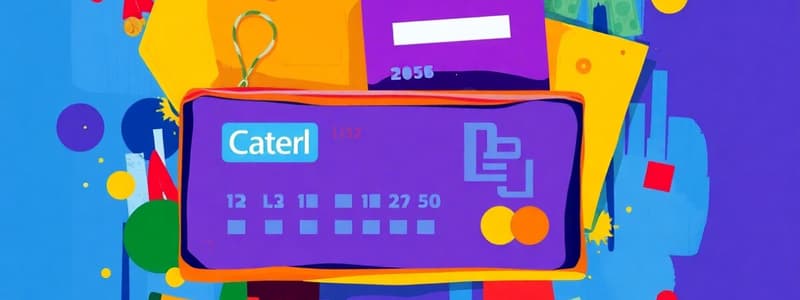Podcast
Questions and Answers
What are two advantages and two disadvantages of using a credit card as a method of payment?
What are two advantages and two disadvantages of using a credit card as a method of payment?
Advantages include building credit history and rewards programs. Disadvantages are high-interest rates and potential for overspending.
In what scenario might cash be the most appropriate method of payment?
In what scenario might cash be the most appropriate method of payment?
Cash is most appropriate in small transactions at local markets or when privacy is desired.
Define 'needs' and 'wants' and provide an example of each.
Define 'needs' and 'wants' and provide an example of each.
Needs are essential items required for survival, like food; wants are non-essential items, like a new phone.
What are two common sources of income for youth?
What are two common sources of income for youth?
Explain the importance of setting a savings goal.
Explain the importance of setting a savings goal.
What are two risks associated with investing in stocks?
What are two risks associated with investing in stocks?
What is the concept of charitable giving, and why is it important?
What is the concept of charitable giving, and why is it important?
How can impulse buying negatively impact a budget?
How can impulse buying negatively impact a budget?
Flashcards
Budget
Budget
A plan that outlines how you will spend your money.
Needs
Needs
Things you need to survive, like food, shelter, and clothing.
Wants
Wants
Things that you want but don't need for survival, like toys, video games, and snacks.
Saving Money
Saving Money
Signup and view all the flashcards
Investing Money
Investing Money
Signup and view all the flashcards
Donating Money
Donating Money
Signup and view all the flashcards
Short-term Financial Goals
Short-term Financial Goals
Signup and view all the flashcards
Long-term Financial Goals
Long-term Financial Goals
Signup and view all the flashcards
Study Notes
Payment Methods
- Different payment methods exist, including cash, debit cards, credit cards, e-transfers, and cheques.
- Cash: Advantages include being readily available and avoiding fees; disadvantages include security concerns and limited tracking.
- Debit cards: Advantages include linking directly to a bank account and immediate payment; disadvantages may include overspending if not managed carefully.
- Credit cards: Advantages include flexibility and building credit history; disadvantages involve interest charges if balances are not paid in full.
- Electronic transfers: Advantages include speed and convenience, reducing theft risks; disadvantages may involve fees if not part of a bank account.
- Cheques: Advantages include providing a record of payment; disadvantages include slower processing and potential for loss or theft.
- Each method has specific situations where it's most suitable (e.g., cash for small purchases, credit cards for larger purchases, or emergencies).
Spending Money
- Needs are essential items (food, shelter), while wants are desired items.
- Budgeting involves creating a plan for managing income and expenses.
- Youth income sources include allowances, chores, and gifts.
- Impulse buying refers to unplanned purchases.
- Impulse buying can lead to financial difficulties if purchases are not aligned with a budget.
Saving Money
- Saving for short- and long-term goals is crucial.
- Saving options include piggy banks, savings accounts, and other alternatives.
- Interest is the reward for saving money.
- Creating a realistic saving plan involves setting goals, tracking progress, and making necessary adjustments.
Investing Money
- Investing involves putting money to work for potential growth.
- Various investments exist, like stocks, bonds, and mutual funds.
- Investing comes with risks and rewards.
- Research and understanding investment options are crucial before making choices.
Donating Money
- Charitable giving involves donating to non-profit organizations.
- Various organizations exist, with different missions.
- Donations support various community causes.
- Researching charities is important and planning fundraisers can support ethical charitable activities.
Financial Goals
- Short-term goals are achieved quickly; long-term goals take more time.
- Financial goals involve setting target objectives and creating a plan for attainment, with steps and adjustments made as needed.
- Financial plans are crucial for reaching goals.
Important Considerations
- Connect financial concepts with real life examples relating to Grade 6 experiences.
- Encourage critical thinking, decision-making, and evaluation of choices.
- Group discussions and activities foster collaborative learning.
Studying That Suits You
Use AI to generate personalized quizzes and flashcards to suit your learning preferences.




